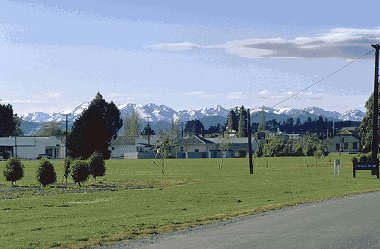![]()
Coasts
Rivers/Lakes
Lowlands/Plains
Geysers/Mud
Glaciers
Mt. Ruapehu
Mt. Cook
White Island
A Maori Legend
![]()
Abbotsford
Aramoana
Ballantynes
Brynderwyns
Cave Creek
Hawkes Bay
H.M.S. Orpheus
Influenza
Mt. Erebus
Mt. Tarawera
Rainbow Warrior
Seacliff Hospital
Tangiwai
Wahine
![]()
Annie Aves
Ata-hoe
Daisy Basham
Jean Batten
Minnie Dean
Mabel Howard
Margaret Mahy
Kath Mansfield
Kate Sheppard
Kiri Te Kanawa
Catherine Tizard
Murray Ball
Charles Goldie
Edmund Hillary
Richard Pearse
Lord Rutherford
Charles Upham
![]()
NZ FAQ--Funny
NZ Links
Credits
On the 12th August 1895, Minnie Dean gained the somewhat dubious honor of being the first -- and last -- woman to be legally hung in New Zealand. Her 'baby farming' hid family shame and offered quick, confidential disposal of illegitimate children. It was the method of disposal which resulted in her hanging. Williamina Dean is thought to have been born in Edinburgh, Scotland, around 1847 (some people put the date earlier). Very little is known about her life prior to 'baby farming', however, she married and had two daughters, what happened to them remains unknown. In 1868 she emigrated to New Zealand and four years later was married to Charles Dean. The innkeeper was declared bankrupt in the late 1880s and the Deans moved to Winton (not far from Invercargill). There they moved into an old two-storey house which burnt to the ground soon afterwards. A small house was built to replace it, this was only 22 x 12 feet. Now Minnie Dean set up her 'baby farming' placing advertisements wanting children for adoption. At times up to eleven children, from newborns to ten-year-olds lived in her little house. "RESPECTABLE Married Woman (comfortable home, country) Wants to adopt an INFANT -- address, childless, Times office." Letters dean wrote to the mothers of illegitimate children were always deeply religious and full of warmth. For a payment of 20-30 pounds the baby was taken off the mother's hands and adopted out -- no questions asked. The sooner baby farmers disposed of the children the greater the profit. As a result, some infants suffered a very early demise. In colonial New Zealand there was no contraception available, abortion often meant death for both mother and child, there was nowhere that would care for illegitimate children, and their mother's were ostracised by society. Many women, who felt they had no other choice, turned to Minnie Dean as the answer to their dilemma. Minnie Irene Dean first came to the attention of the authorities after a six-month-old baby in her care died three days after being taken ill. Two years later a six week old baby, again in her care, also died. The official cause of death in the first case was convulsions. After an inquest was held the death of the second baby was put as being from natural causes. The coroner advised that the numbers of children living in her home should be reduced and living conditions improved. Neither of these happened and things continued as before -- the only change being that Minnie Dean started advertising under false names. . Though no more deaths were reported it was observed that children seemed to be disappearing. Police could do nothing as child welfare laws of the time were woefully inadequate. The authorities could not even enter the house and search it, nor did Minnie Dean have to supply them with records of her transactions (leaglly she wasn't even required to keep any). It was in May 1895, that a railway guard said he had seen her board a train with a baby and carrying an old tin hatbox. It had been observed that when she disembarked at Lumsden the child was not with her. The next day she again boarded the train carrying her hatbox and was handed a young baby, but upon leaving the train she was carrying only the hatbox and a parcel. Now police started an investigation; enquiries led them to witnesses who had carried the hatbox on board and said it was very light, then onto other witnesses who stated it was heavy when they carried it off. In Dunedin a Mrs Hornsby revealed she had handed over some money and her one-month-old grand-daughter to Dean at Milburn. Mrs Hornsby was taken to Dean's home where she identified Minnie Dean as the woman she had handed the baby over to and found clothing belonging to her grandchild. As a result Dean and her husband were arrested and transferred to Dunedin to await trial. Police searched the garden and located the bodies of three babies. The bodies were those of Eva Hornsby, Dorothy Edith Carter (passed over to Minnie Dean by her grandmother); the third was unidentified. Two charges of murder were laid against Minnie and Charles, but after further enquiries all charges against Charles were dropped. It was obvious that her rather dull husband had no idea of her activities. At the trial it was theorised Minnie Dean had killed the Carter child with an overdose of laudanum (an opiate) on the train to Lumsden, concealing the body in her hatbox. Staying overnight in Lumsden, she re-boarded the train and went to meet Mrs Hornsby. The two women travelled for a while on the same train, then Minnie disembarked with little Eva. Soon after, the baby was asphyxiated and her body wrapped up in a parcel. She then returned home carrying the two dead children. Her reasons for committing the crimes were considered to be a combination of insanity and a desire for easy money. The final verdict found her guilty of the murder of Dorothy Edith Carter and Minnie Dean was sentenced to death by hanging. Her death served to satisfy public anger which was running high. It also eased the guilt society felt for not having better child welfare laws. The case caused major changes in legislation. Charles Dean claimed his wife's body after the hanging and it lies in an unmarked grave in the Winton cemetery. All legal executions which have been performed in New Zealand were by hanging, but no records have been kept of numbers. There were 21 recorded hangings between 1880 and 1900 and many more prior to that. Executions were done in public before 1862, after which they were done behind prison walls. The few records that have been kept show all recorded hangings were for the crime of murder, although earlier hangings may also have been for burglary with violence, sodomy and arson. Three women were sentenced to death in New Zealand for murder; these were in 1872, 1883 and Minnie Dean in 1895. Of these three only Dean was executed (at Invercargill goal), the other two had their sentences commuted to life imprisonment.
|


